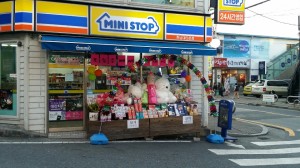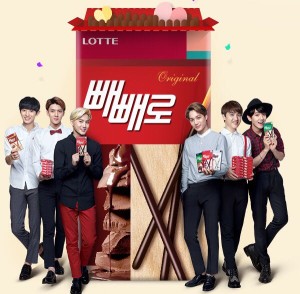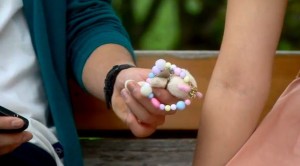 November 11 marks the celebration of Pepero Day: an unmistakably corporate holiday that is marketed heavily by South Korea’s Lotte Corporation. Lotte is so successful in this endeavor that Pepero Day sales (from October to November) make up half of the candy company’s annual profit. It’s impossible to miss the signs of Pepero Day approaching. Stands and towers of Pepero and romance themed gifts pop up just about everywhere, even in stores that may not otherwise carry candy products regularly. Idol group endorsements also flood the media (this year with Exo and Red Velvet).
November 11 marks the celebration of Pepero Day: an unmistakably corporate holiday that is marketed heavily by South Korea’s Lotte Corporation. Lotte is so successful in this endeavor that Pepero Day sales (from October to November) make up half of the candy company’s annual profit. It’s impossible to miss the signs of Pepero Day approaching. Stands and towers of Pepero and romance themed gifts pop up just about everywhere, even in stores that may not otherwise carry candy products regularly. Idol group endorsements also flood the media (this year with Exo and Red Velvet).
South Koreans celebrate Pepero Day much like Valentine’s Day. In lieu of valentines, they exchange boxes and sticks of the popular chocolate-coated cookie sticks (worry not — there’s a space on the back dedicated to writing your own love message to the recipient). Variations of Pepero candies and boxes are often exchanged between friends, co-workers and, of course, couples.
 Pepero Day is one of a slew of ‘couple’ holidays celebrated in South Korea. It seems there’s about one couple holiday celebrated every month (generally on the 14th) with the most notable being Valentine’s Day, White Day, Pepero Day and Christmas.
Pepero Day is one of a slew of ‘couple’ holidays celebrated in South Korea. It seems there’s about one couple holiday celebrated every month (generally on the 14th) with the most notable being Valentine’s Day, White Day, Pepero Day and Christmas.
Despite its corporate history, Pepero Day remains a favorite couple holiday among young South Koreans. (Also a favorite for international fans, who understand Pepero Day, is an opportunity to watch band members play the notorious ‘Pepero Game.’)
Beyond simply the excitement of free chocolate, gift giving and exchanging is one of the pinnacles of traditional South Korean culture. Gifts are exchanged to display gratitude, respect, affection and to maintain kibun (a healthy state of mind). Couples not only exchange gifts on one of the multiple couple holidays, but also regularly in-between.
On days like Pepero Day, South Korea’s overt and materialistic couple culture becomes even more apparent than usual. Couples revel in the opportunity to display their affections not only to one another, but also to the general public.
The spectacular nature of Korean courtship is a topic Korean dramas play on regularly. It’s something we’ve all witnessed in dramas: the 100 days anniversary, the celebration of White Day, the (awful) couple outfits, couple rings, generous gift giving, and obsessive phone relationships. What many assume is an exaggeration for the sake of television is quite an accurate reflection of the reality of (youth) couple culture in South Korea.
 Where others may demonstrate their couple-ness through PDA, it is more appropriate in South Korea to show off one’s taken status with material possessions. This is because up until recently, public displays of affection were considered majorly taboo. Although couples do litter the streets (you seriously can’t go anywhere without being surrounded by couples), their physical affections are generally limited to hand holding. Public displays of couple outfits, couple rings, matching phone charms, etc. become an acceptable way of boasting one’s taken status while maintaining public face.
Where others may demonstrate their couple-ness through PDA, it is more appropriate in South Korea to show off one’s taken status with material possessions. This is because up until recently, public displays of affection were considered majorly taboo. Although couples do litter the streets (you seriously can’t go anywhere without being surrounded by couples), their physical affections are generally limited to hand holding. Public displays of couple outfits, couple rings, matching phone charms, etc. become an acceptable way of boasting one’s taken status while maintaining public face.
Why, then, do dramas make such a big deal out of the exchange of couple items? One reason is the tradition of gift giving, in which the exchange of couple items would solidify a couple’s appreciation of one another. The case of matching couple attire has no intrinsic base in Korean culture. Rather, it can be understood as a significant modern representation because in South Korea dating is still considered a means for marriage. Rarely would a relationship be publicly displayed if both partners did not at least see the potential for marriage in the future. We’ve all seen the quintessential drama moment where the male lead publicly claims the female as “his woman.” This isn’t gasp-inducing because he’s casually saying ‘oh hey, we’re together now’ but because this declaration is understood as an intention for a future union more often than not. The same public announcement, although slightly less dramatic, is displayed through couple outfits.
Korean dramas are not real life. But they’re an ideological reference point to the fantasies and customs of real life. This goes from the proclamation of couple status to the consumeristic nature of courtship. Viewers who tune in to Korean dramas find themselves fantasizing for a love like the one they see play out on the screen. The material aspect of drama romances is one of the most accessible points of entry to live that fantasy. Because, realistically, you probably aren’t going to find a tsundere chaebol with an evil mother and a second male lead who will duel for your affections. But you probably can find a cute couple sweater and convince your significant other to wear it with you on the streets of Hongdae.
 Popular culture no doubt has an affect on the market, and the fantasies told through Korean dramas actively promote the continuation of the materialistic couple practices of real life relationships. Think of it like an ideological product placement than manifests itself in tangible products: dramas are the simulation, couple products and practices the representation.
Popular culture no doubt has an affect on the market, and the fantasies told through Korean dramas actively promote the continuation of the materialistic couple practices of real life relationships. Think of it like an ideological product placement than manifests itself in tangible products: dramas are the simulation, couple products and practices the representation.
In short, celebrations like Pepero Day and White Day are the brain children of billion dollar corporations the same way material couple culture has no real history other than pure consumerism (other than gift giving). But these practices are perpetuated in the space of popular culture like dramas and acted out as a reality by the general public.
At the core of it all, couple culture and holidays provide an innocent chance at fun and free candy (unless of course you’re perpetually single — then you can celebrate Black Day on April 14). South Korean couple culture exists as a never-ending cycle of seeing, desiring, purchasing and boasting… but the couple outfits are getting slightly less embarrassing, so at least there’s that.
(Wall Street Journal, Korea Times, Hiexpat, Images via Lotte, MBC Youtube, SBS)


